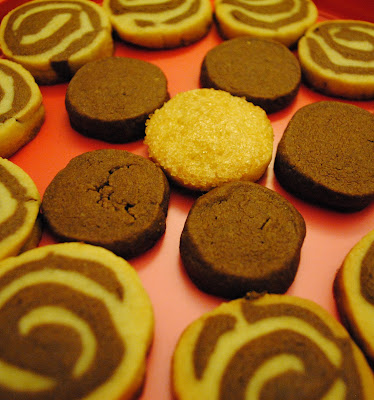For this year's Second Annual Make-Christmas-cookies-for-Chefski's-family (and mine!) Baking Day, I decided to try something a little special, a little nostalgic, and I knew I'd found what I was looking for when I stumbled on a recipe for French Butter Cookies. You may remember these from that ubiquitous blue tin often sold in drug stores or ::gasp:: Woolworth's of yore. Buttery, even sandy-feeling (in a good way), these cookies take a bit of time and effort, but it was worth it just to hear my mother tell me how much she really liked them -- and she's not even a cookie person!
Here's how I adapted the recipes I found on Annie's Eats:
French Butter Cookies
For the dough
1 large egg
10 Tablespoons unsalted butter, softened
1/3 cup plus 1 Tablespoon sugar
1/4 teaspoon salt
1 teaspoon vanilla extract
1 1/2 cups unbleached all purpose flour*
*For the Black n Whites, make one batch of FBCs as directed, and one using only 1 1/3 cups flour + 1/4 cup Dutch-processed cocoa powder
1 1/2 cups unbleached all purpose flour*
*For the Black n Whites, make one batch of FBCs as directed, and one using only 1 1/3 cups flour + 1/4 cup Dutch-processed cocoa powder
For finishing
1 large egg white + 1 teaspoon water, lightly beaten
Turbinado sugar for sprinkling
1. Soft boil your egg by placing it in a pot of water, with about an inch covering it. Bring the water to a boil, then remove the pot from the heat and allow the egg to sit in the boiling water for 10 minutes.
2. Next, place the the egg in a bowl of ice water and let stand for 5 minutes. This will make peeling the shell off much easier.
3. Separate the white from the yolk, and discard (read: eat) the white.
4. Place the yolk in a large bowl. Add the butter, sugar, and salt, and then with a hand mixer beat the mixture until light and fluffy. Be sure to scrape down the bowl occasionally as the mix attempts to escape your bowl.
5. Add vanilla. I actually went up to 1 tablespoon for my cookies, and was so pleasantly surprised by the vanilla flavor that I'll definitely be doing this in the future.
6. Add the flour and mix until just combined. Using a spatula, press dough down into a ball.
7. If you're making the regular butter cookies, divide you dough in half, and then roll each ball into a log about 6 inches long, with a 3.75 inch diameter. Roll in parchment paper, twisting the ends closed, and chill in the freezer for an hour. As this point, you may freeze your dough, in freezer bags, for up to two weeks (this will definitely come in handy in the future).
8. After your dough has firmed, you may slice the dough into 1/4 inch rounds. Brush on the egg white mixtures and sprinkle with turbinado sugar. These cookies will be so sparkly and crunchy once baked!
9. Bake on a parchment-lined baking sheet for 15 minutes at 350 degrees F. Enjoy.
Black and White Spiral Cookies
Basically the same ingredients as for the French Butter Cookies, and you'll need one batch (or a 1/2), but, as stated above, to make the "Black" part, sub in 1 1/3 cups flour + 1/4 cup Dutch-processed cocoa powder in place of the 1.5 cups flour.
In my case, I couldn't find Dutch-processed cocoa, so I consulted baking 911 on how to substitute natural cocoa powder for Dutch (3 Tablespoons natural + 1/8 teaspoon baking soda = 1 Tablespoon Dutch).
Directions
1. If you made full batches of each, divide in half as directed for French Butter Cookies.
2. Roll each out separately into rectangular sheets about 6 by 8 inches, and 1/4 inch thick.
3. Place one chocolate sheet atop a vanilla sheet, then starting at the long end, roll the dough cinnamon-roll style, creating a tight log.
4. Chill in the freezer for 1 hour. Slice and bake for 15 minutes at 350 degrees F.
5. If you've got extra chocolate dough, as I did, just roll those up a la French Butter Cookies, chill, slice, and bake on their own.
6. Allow to cool, pack up and deliver as gifts :)



